
Suga Waterfall
Suga Waterfall, 5-Story Pagoda, and Shrines
After a wonderful
breakfast
on my first full day at Mount Haguro,
I was ready to hike to the top.
But it was raining a little heavily in the morning,
so I hung out at the ryokan for a couple of hours
until the rain decreased.
Then it was a short walk through the town largely made up
of former Shukubo pilgrim lodges,
plus several that are still operating as such.
That took me to the main entrance gate onto the path,
and the sites at its base.
That includes a cluster of small Shintō shrines,
Hagurosan Gojunoto
or the Five Story Pagoda,
and the Suga waterfall
and the Haraigawa Shrine
beside the Harai River.
Then you're ready for the 2,446 stone steps
up the 1.7 km path through the cedar forest,
climbing about 280 meters of elevation
from 140 m at the river to 420 m at the summit.
And so,
Yamadera
with its 1,015 stone steps climbing about 160 meters
had been a nice warmup.
To the Start of the Climb
It was a short walk of just 750 meters from the Tamonkan ryokan where I was staying to the entrance. It was a nice walk, past some older houses and some pilgrim lodges. See the later page on Haguromachi for pictures and explanations from my leisurely strolls through town.
In this picture the main road through town swings past on the right, and the path up Mount Haguro begins through the torii or gate to the left.

Notice the yellow ceramic tile path marker on the sidewalk. Japanese sidewalks are pretty much universally marked for people with low to no vision. The route is marked with a four-line path, changing to a grid of small bumps at junctions and transitions to cross streets.
I think that's very nice! Back home in the U.S., there are legal requirements for a small plate of bumps at curb cuts for street crossings. There's a plate of bumps about the size of a doormat at the edge of the sidewalk on one side of the street. Then, somewhere across four lanes of traffic, is a similar plate of bumps at the edge of the sidewalk on the other side. But of course there's no guidance for walking along the sidewalks, let alone crossing the street. Nor is the path between them unaligned with the plate at either end. Freedom!
The torii or gates at Shintō shrines are like doorways and gates at Buddhist temples, Judaism's Holy Temple in Jerusalem, Christian churches, and Islamic mosques — they mark passages into increasingly sacred space. Sometimes they are plain wood or concrete, often they are painted a bright vermilion.
The vermilion column to its right is a mail box. During my visit in 2023 Japan was accompanying the rest of the world into a post-postal existence. However, shops to the left sold various souvenirs along with postcards to commemorate and share your visit to a significant spiritual site.
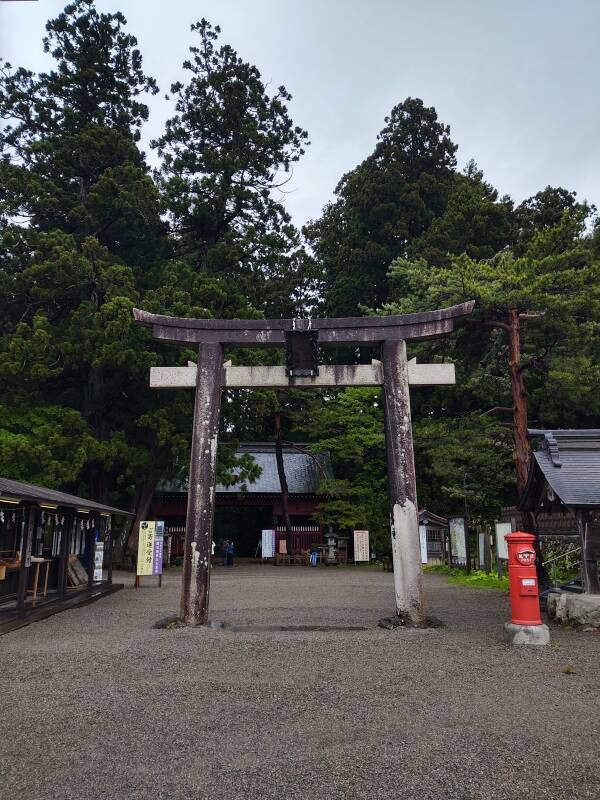
The Tenchikon Shrine is off to the right as you approach the path entrance.

It's a blend of Shintō and Buddhist features. Most of the people in Japan today are pretty vague about the precise details of Shintō and Buddhism, and so few people are really confused by, or actually notice, the mixture.
I was trying to be the Good Visitor, carefully reading about the historical and cultural background to better understand and appreciate what I was seeing. A Buddhist priest at a temple here was delighted to tell me that I seemed to understand Japanese religion better than most Japanese people. Which seems to be kind of a low bar, to be honest. But I was happy to be told that!
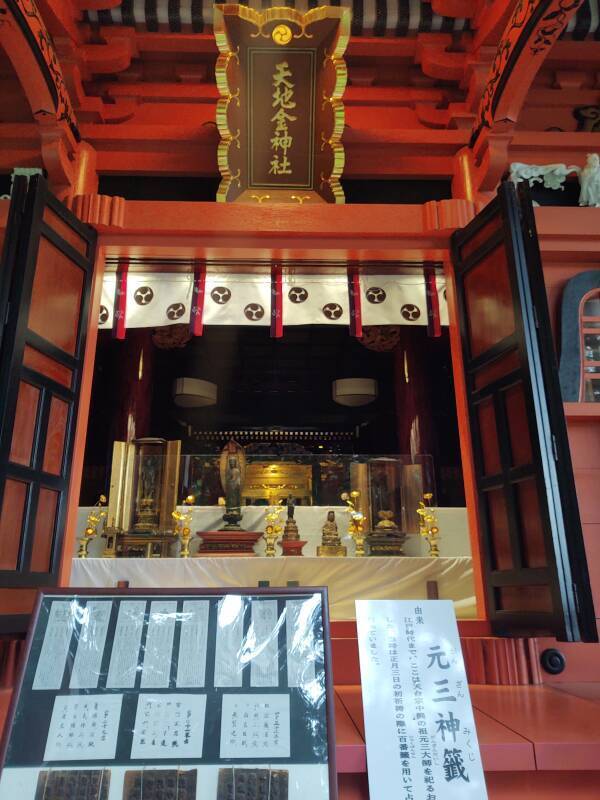
The entrance to the grounds of a Buddhist temple is typically a gate with a guardian statue on each side. Mon is a gate. Niō are the deities, warriors wielding weapons with the left one's mouth open and the right one's mouth closed, together pronouncing the holy syllable ॐ or Om. The Niō prevent evil-doers and misfortune from passing through the gate. And so, the gate is commonly called a niōmon.
The Meiji Restoration of 1868 led to Buddhism being supressed in favor of newly revised and re-emphasized Shintō and the cult of the Emperor being directly descended from the gods. And so, the Niōmon became the Zuishinmon The new name is said to refer to something like "the gods who stayed the same since ancient times", which sounds a little propagandistic to me.
Here's the gate. It was built back in the late 1600s by the lord of the Yajima clan in Akita. A Buddhist priest was blowing a conch shell when I first arrived.

Onto the Path, Down to the River
You pass through the gate into the forest of sugi, the towering cryptomeria or Japanese cedar trees.
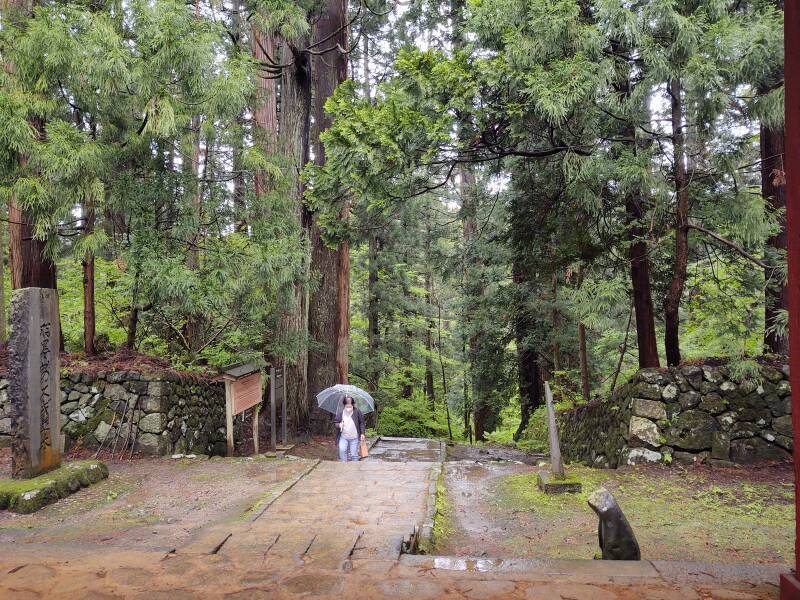
You begin by descending to a cluster of small shrines.
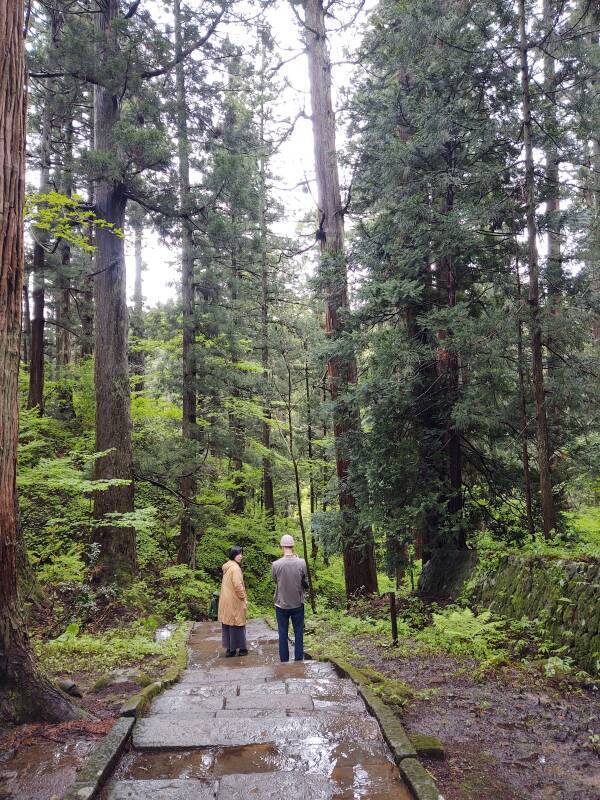

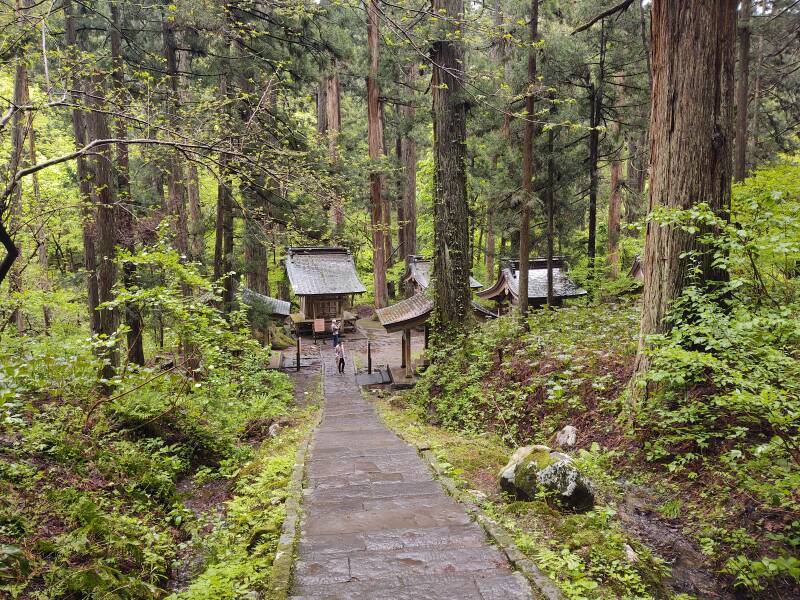
An Initial Cluster of Shrines
There are Shintō shrines to all sorts of deities — specialists, generalists, and the vague. For example, Uganomitama-No-Mikoto, the god of agriculture, and Ideha-No-Kami, the god who watches over all of what was once Dewa Province, plus multipurpose shrines for whichever deities of the moment that you might be considering. It reminds me of Paul's observation of Άγνωστος Θεός, Agnostos Theos, the Unknown God in the Athens agora.
One of the first shrines along the path is the Iwasaku Shrine.
Enshrined:
Iwasaku no Kami
Deity of sword and vitality
Divine virtue: Improvement of vitality

Nesaku Shrine
Enshrined:
Nesaku no Kami
Deity of sword and vitality
Divine virtue: Improvement of vitality
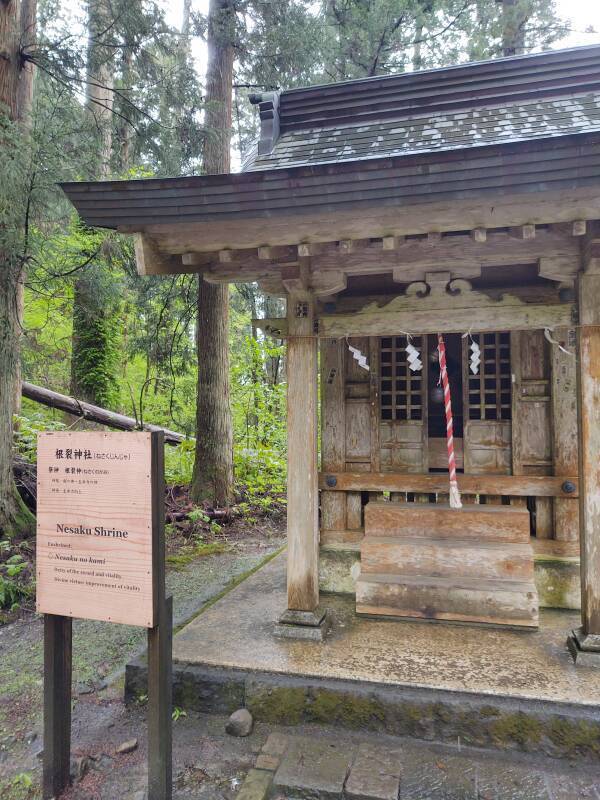
The hanging rope used to shake the rattle and awaken the deity is an obvious Shintō feature, as are the shide or zigzag paper streamers. Inside — no surprise — there are no figures, no representation of bodhisattvas or manifestations of the Buddha. It's strictly Shintō.

Itakeru Shrine
Enshrined:
Itakeru no Kami
Deity of seeds and plants
Divine virtues: Shipbuilding, rich haul (fishery),
navigation safety,
business prosperity,
good fortune,
prevention of disease
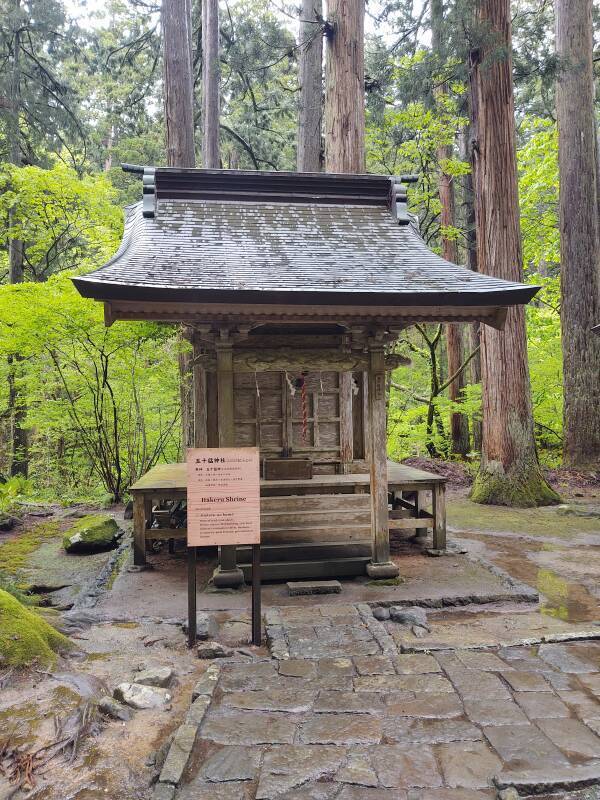
Ōtoshi Shrine
Enshrined:
Ōtoshi no Kami
Deity of grains and agriculture
Divine virtues: Abundant harvest,
industrial prosperity,
household safety,
good fortune,
prevention of disease,
conjugal harmony,
matchmaking
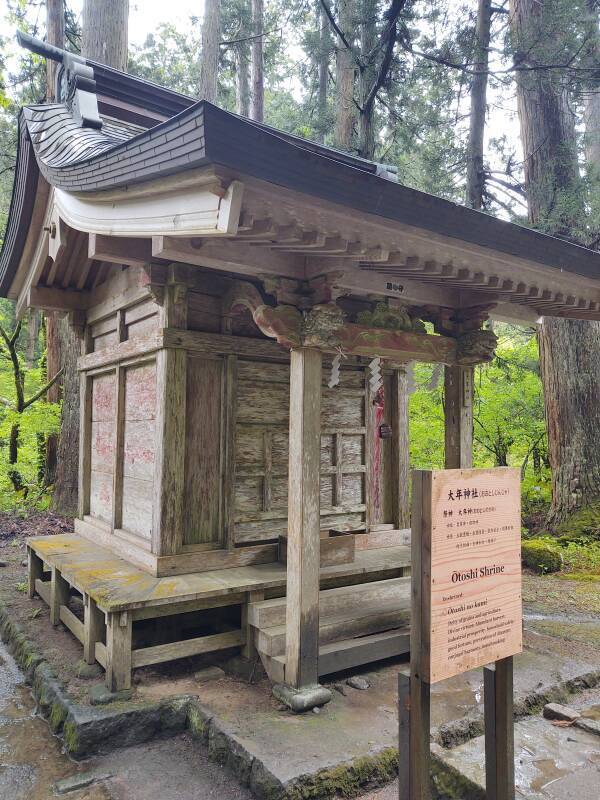
Tenjin Shrine
Enshrined:
Tenjin no Kami
Deity of grains, medicine, and hot springs
Divine virtues: Homeland tranquility,
industrial development,
disease treatment,
fishery protection,
navigation protection

Toyotamahime Shrine
Enshrined:
Toyotamahime no Kami
Deity of ocean and water
Divine virtues: Safe delivery,
prosperity of descendants,
agricultural protection,
fishery protection,
navigation safety
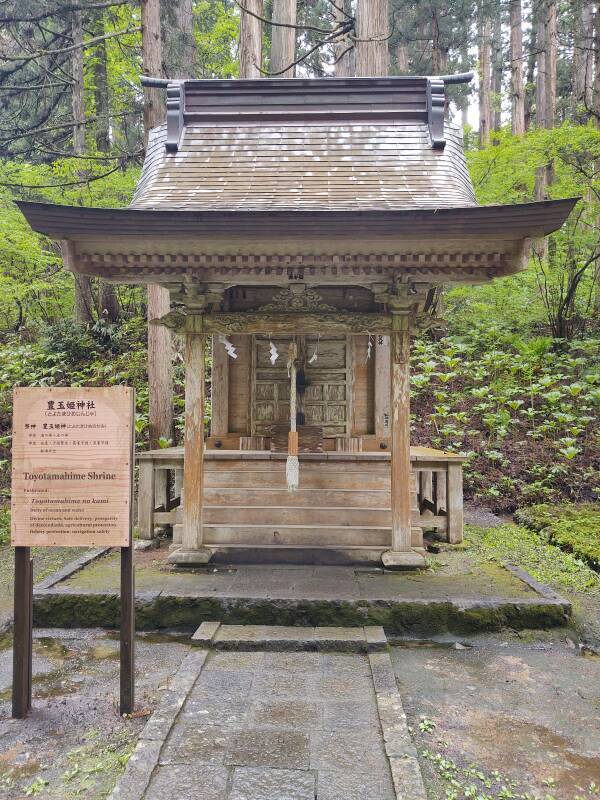
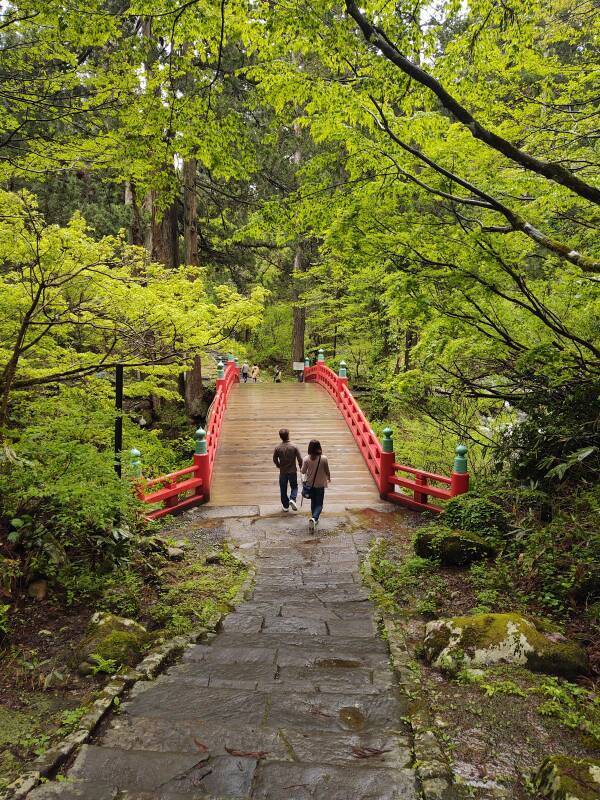
Harai River, Suga Waterfall and Haraigawa Shrine
The path continues down to a broad wooden bridge over Harai-gawa, the Harai River. Or, as Google Maps heretically suggests, the Kyoden River.
Harai-gawa or "the River of Purification" is where pilgrims and resident ascetics would engage in purufication ceremonies before continuing up the path to the summit.
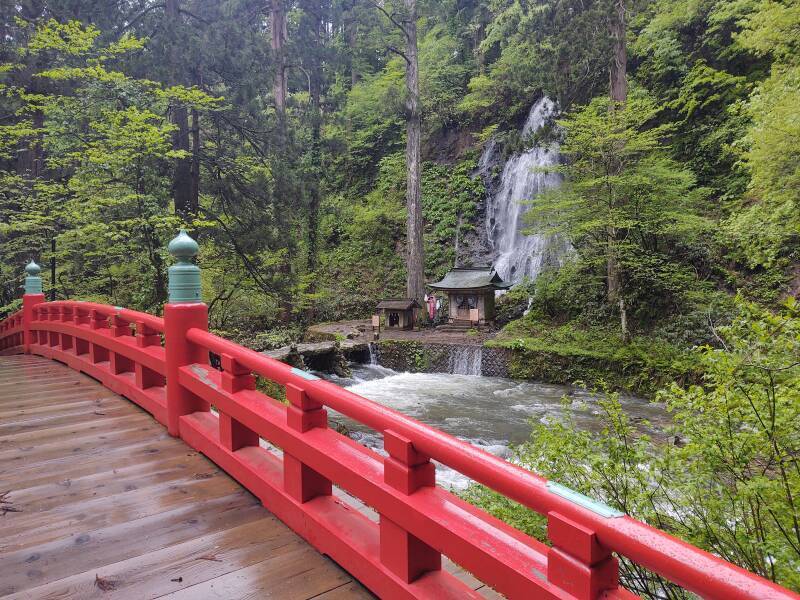

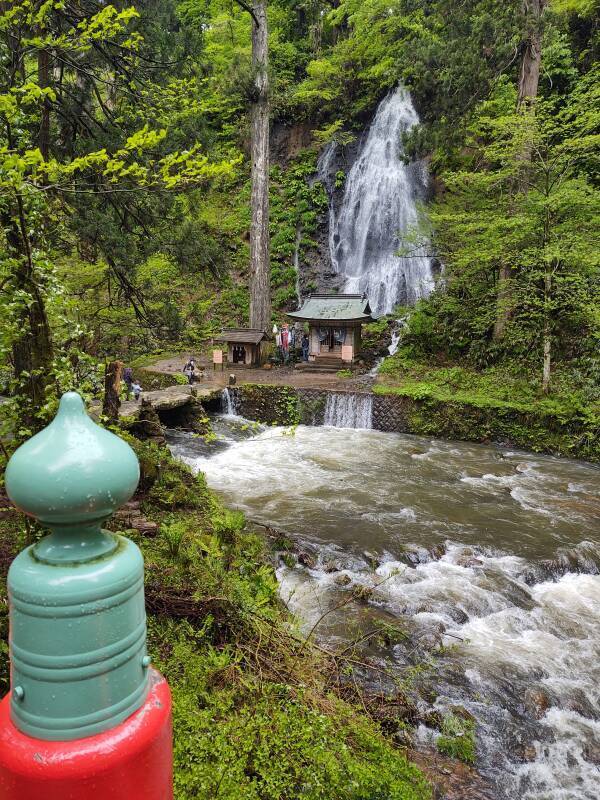
Yes, water is flowing across the far end of the bridge and across the walkway. Just walk through it, get purified.
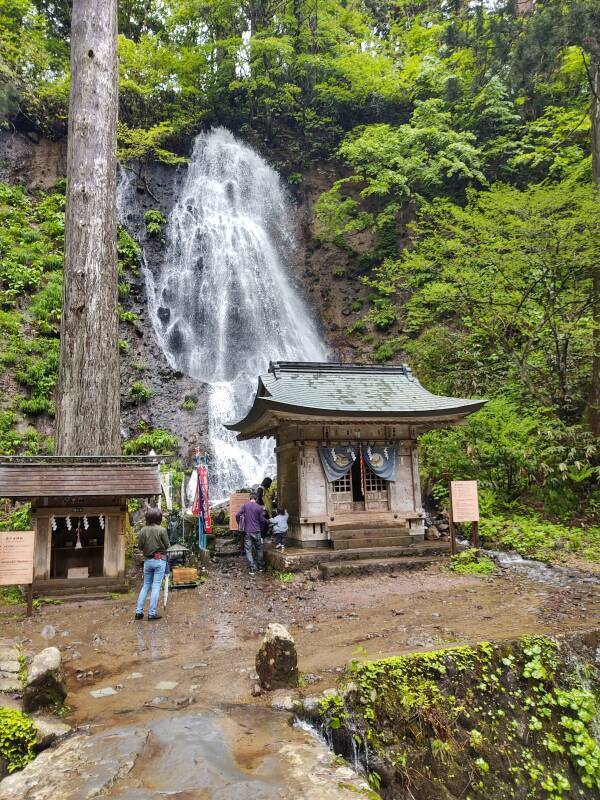
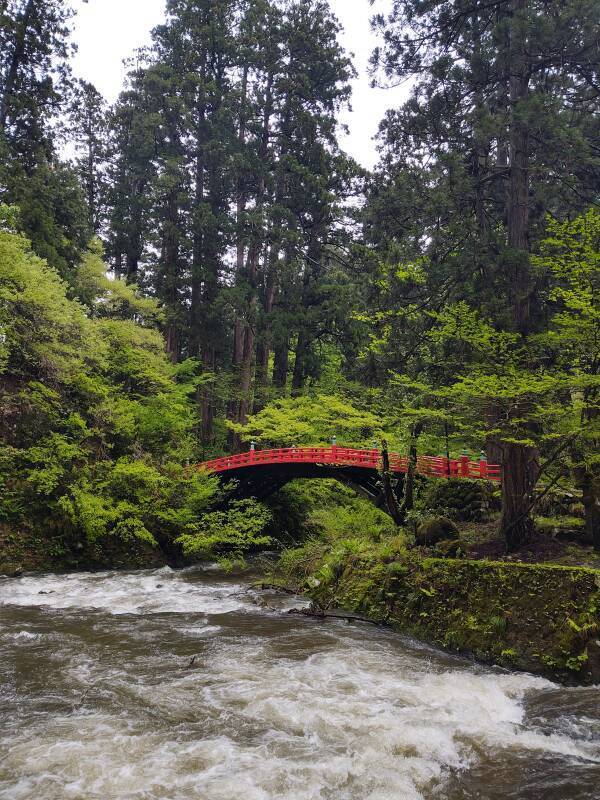

A rope hanging down from rattles between shide streamers, no figures outside or inside, the above is definitely Shintō.
Looking inside, there are Shintō fox guardian figures at either end of the altar table. And... a very Buddhist looking figure near the center. It's Japan, don't expect theological consistency.
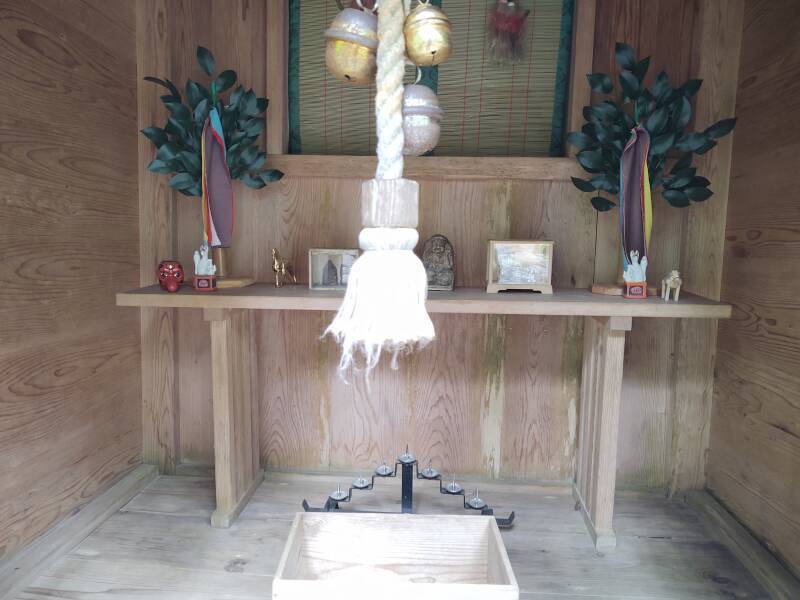
The sliding doors on the main shrine at the base of the waterfall were closed on one visit, and slightly open on another.

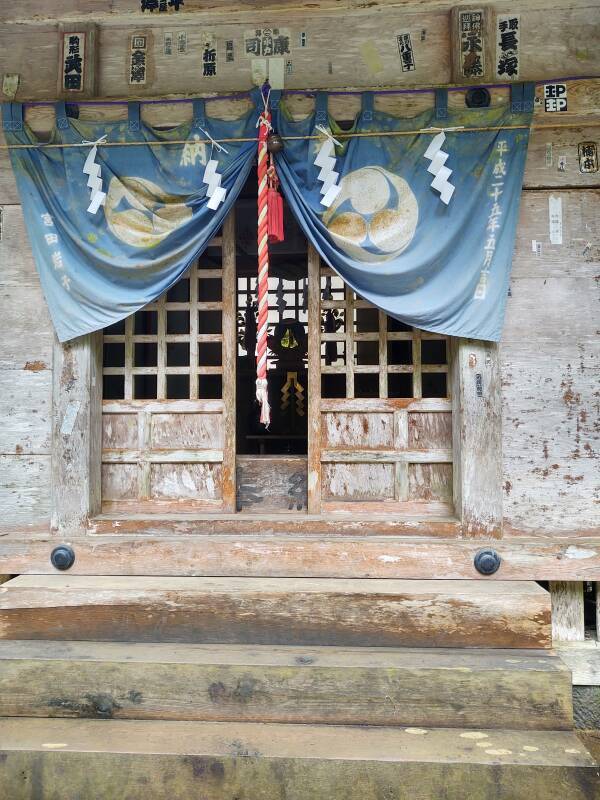
The round mirror as the central object is an extremely Shintō feature, adding to the shide zigzags.
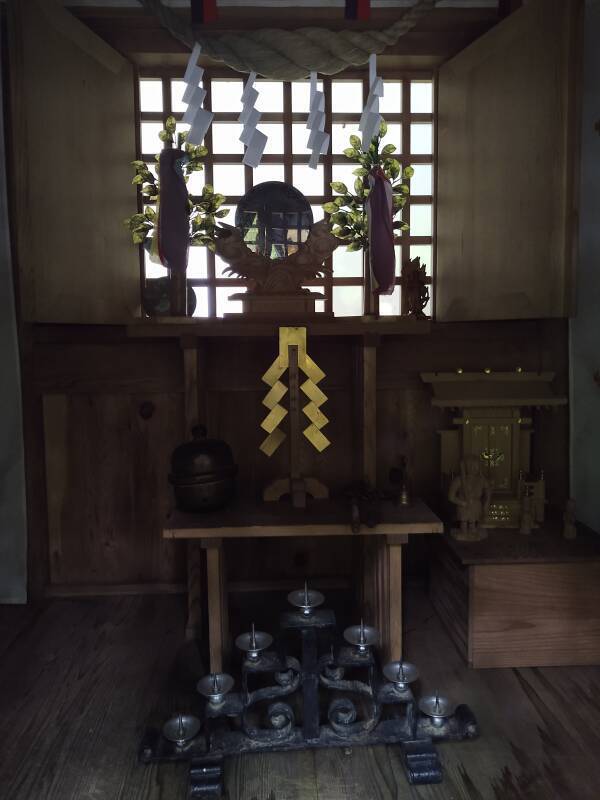
Outside, there's a Buddhist figure standing beneath a collection of banners. The sign says:
Haraigawa, Harai River
This river is named Haraigawa, or "the River of Purification", as pilgrims and ascetics went down to this river to engage in purification ceremonies to exorcise one's misfortune and prevent national calamity.
Suga-no-taki, Suga Waterfall
In 1634, Ten'yū, a political/managerial chief priest (bettō), built a dam at Mizunomizawa located 8 km south of Mount Haguro. He traveled around Sugi-ya-mori to draw water all the way down to Inju-minami, and finally to this overhanging cliff. The waterfall was called Fudō-daki or Haraigawa-no-taki. During 1870 [during the Meiji Restoration], the first shrine chief priest (gūjī) Sugao Nishikawa altered the name of this waterfall to Suya-no-takī (Suga Waterfall). The name derives from the story about Susanō no mikoto [the brother of Amaterasu, goddess of the sun and ancestor of Japan's Emperors] and Kushinadahime no kami [one of Susanō's wives] feeling refreshed for the first time upon arrival at Suga in Izamo, when they searched the land to construct a shrine.

Jiji-sugi, "Grandfather Cedar"
Jiji-sugi or Grandfather Cedar is designated as a national natural monument.
This tree is estimated to be over 1,000 years old and, at 43 meters in height, is thought to be the tallest tree on Mount Haguro.
It's encircled by a heavy rope with shige strips, as it's an object of Shintō veneration.
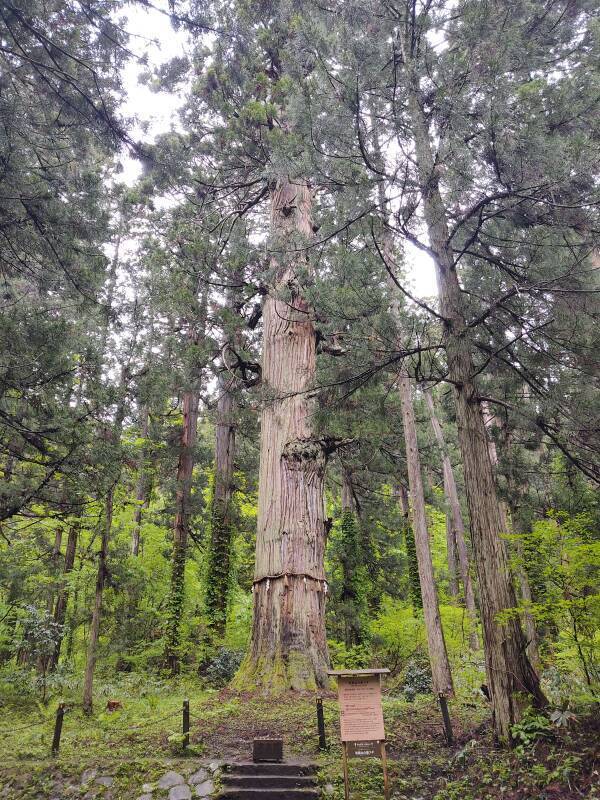
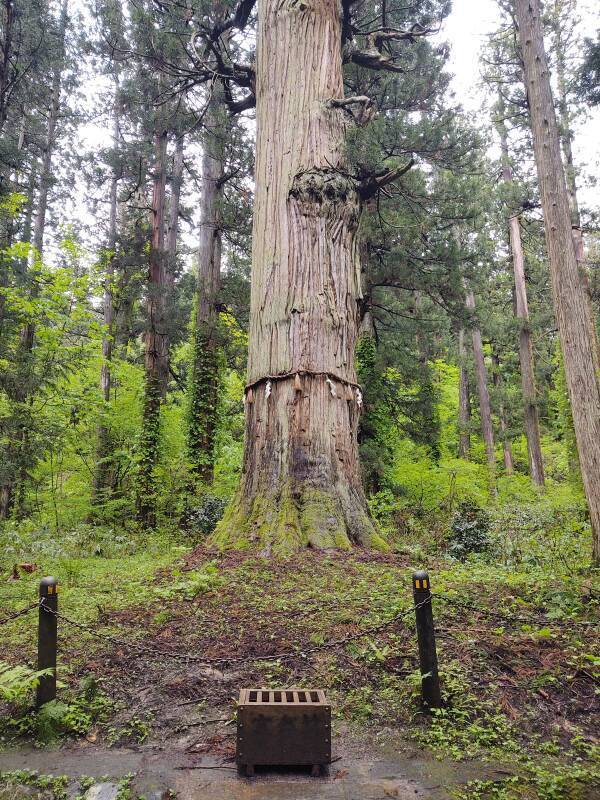
A similarly large tree called Basugi or Grandmother Cedar used to stand nearby, but it fell down during a typhoon in 1902. The legend says that Jiji-sugi, left alone, cried for three days and three nights.
Five Story Pagoda
Gojunoto or the Five Story Pagoda was originally built during the Heian Period of 794–1185 CE. The pagoda you see today is a reconstruction finished in 1372. Long after the original, but still quite old today.
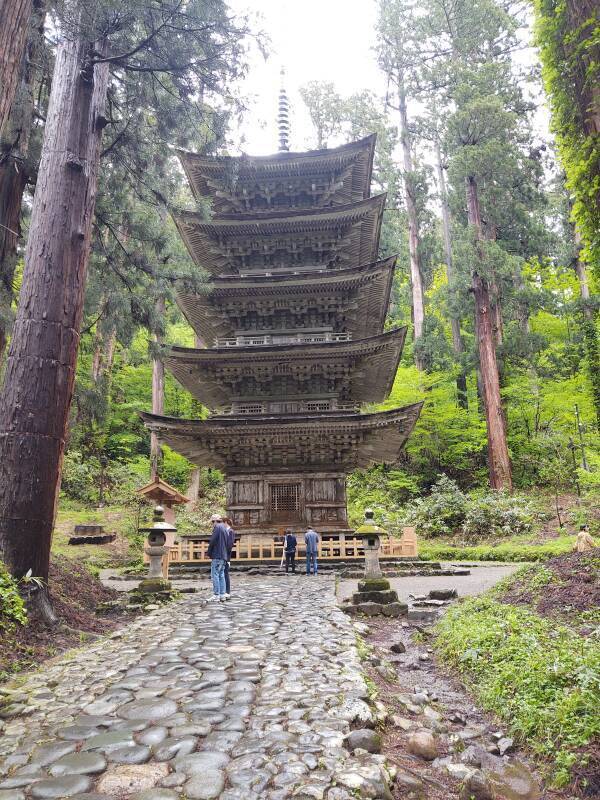
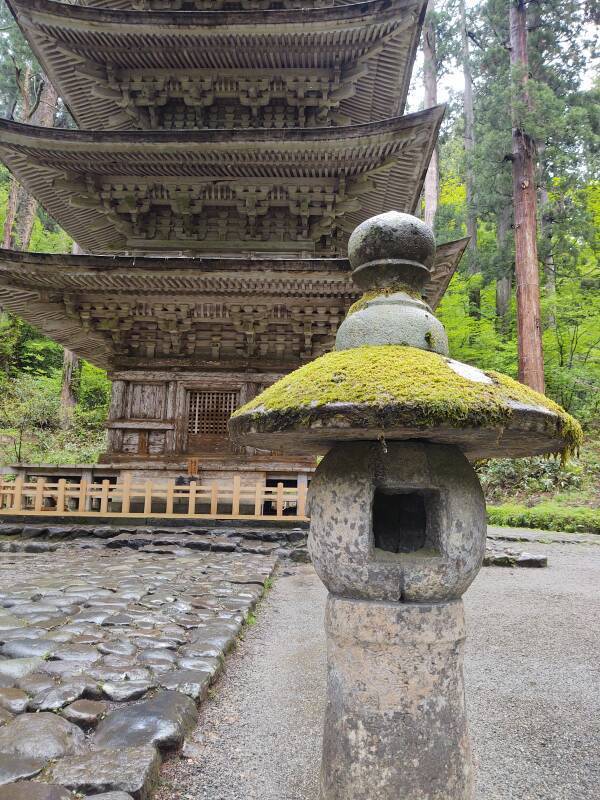
It's very moist down by the river and the waterfall. These stone lanterns are covered with moss.
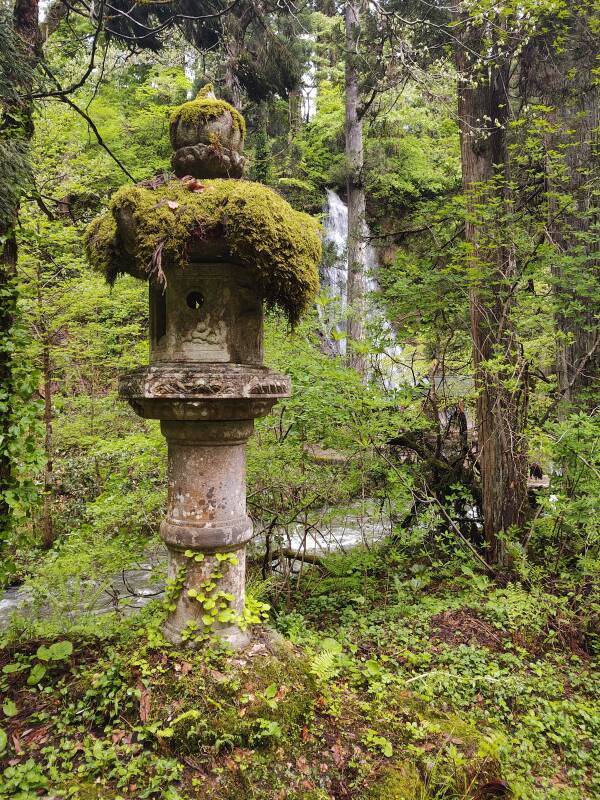
The pagoda is built in the Shirakizukuri style with the wood in its original natural color. There are no nails, all joints are secured by wooden fittings such as notches and pins.
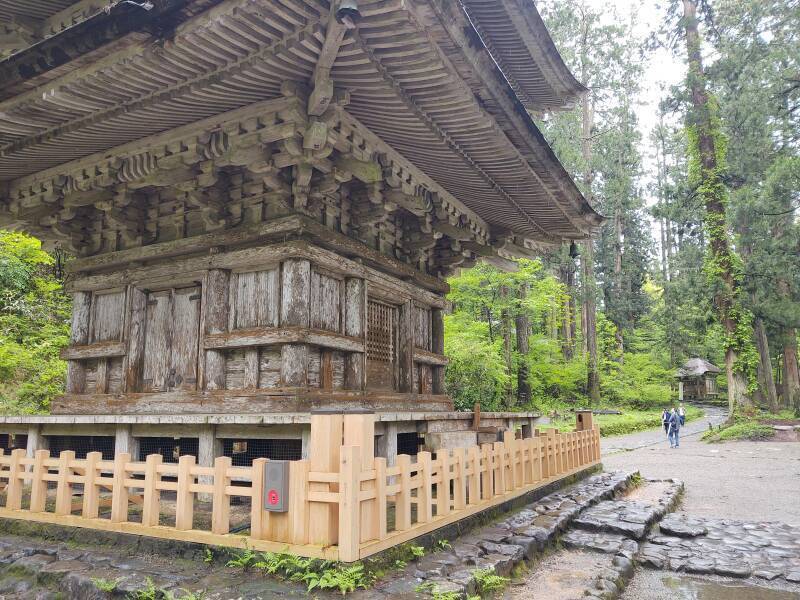
Unlike most pagodas, the roofs taper only slightly in width from bottom to top. Snow can accumulate to three meters deep, so only the top roof needs to be specially reinforced to hold the weight.
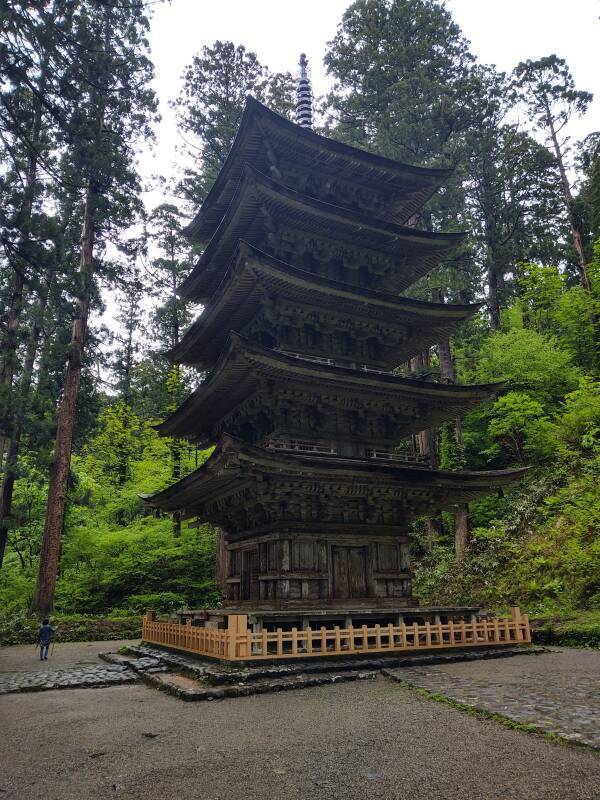
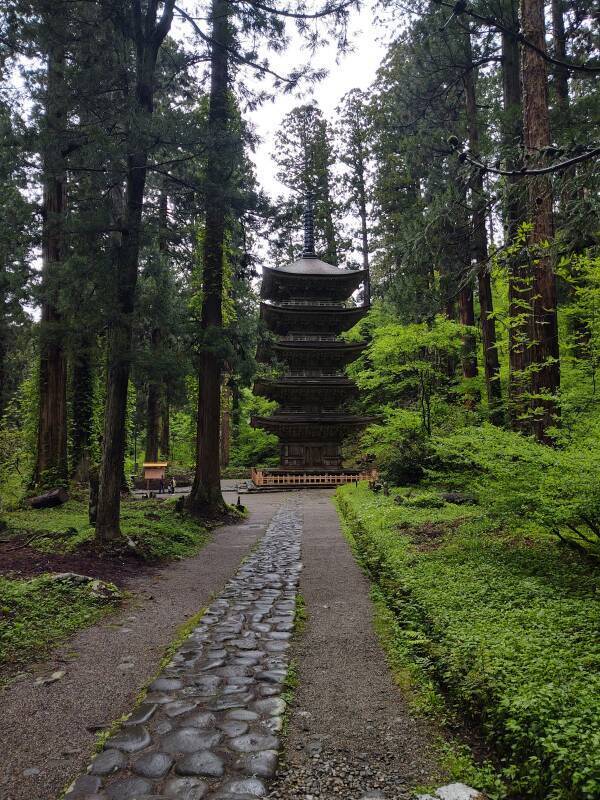
The pagoda has an earthquake dampening system. A large pendulum hangs down inside the pagoda, suspended from the uppermost level. It's an early seismic damper. An earthquake makes the pendulum swing in a way that counteracts the force on the structure.
In the last picture above we're looking back at the pagoda from the main path up the mountain. Let's go up!
Other topics in Japan:



































